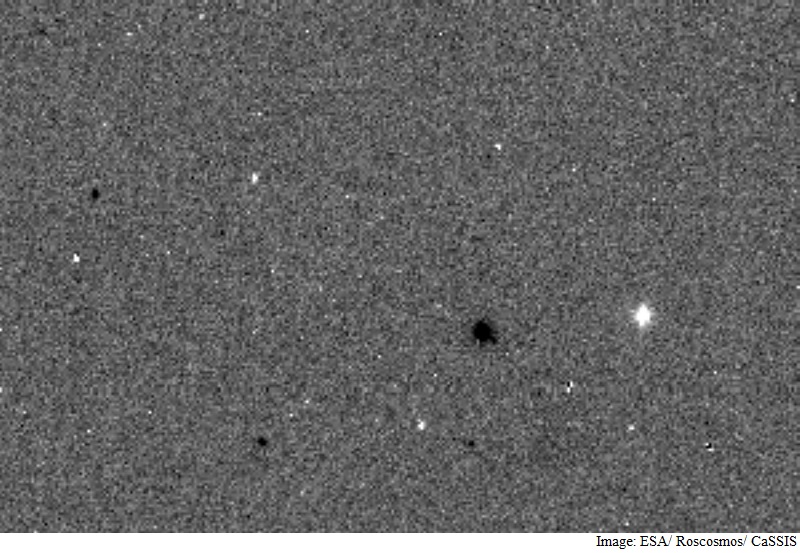- Home
- Science
- Science News
- ExoMars Probe Sends First Pictures Back to Earth
ExoMars Probe Sends First Pictures Back to Earth

Launched on March 14 on a Russian Proton rocket, the craft is designed to "smell" Mars' atmosphere for gassy evidence that life once existed on Earth's neighbour, or may do so still.
The probe's high-resolution camera was switched on for the first time on April 7, and took its first grainy, black and white snapshots of space.
"These first images are very reassuring. Everything points to us being able to get good data at Mars," said Nicolas Thomas from the University of Bern in Switzerland, camera principal investigator.
With its suite of high-tech instruments, the probe should arrive at the Red Planet on October 19 after a journey of 496 million kilometres (308 million miles).
"All systems have been activated and checked out, including power, communications, startrackers, guidance and navigation, all payloads and Schiaparelli," ESA spacecraft operations manager Peter Schmitz said.
Its main mission is to photograph the Red Planet and analyse its air. The spacecraft is also piggybacking a lander dubbed Schiaparelli, which it will release onto Mars for a few days in October.
Schiaparelli will test heat shields and parachutes in preparation for a subsequent rover landing on Mars, a feat the ESA said "remains a significant challenge".
ExoMars is a two-part collaboration between the ESA and Russia's Roscosmos space agency.
This first part is dubbed ExoMars 2016.
The second, the Mars rover phase, was originally scheduled for launch in 2018, but the ESA has said it will likely be delayed over money worries.
There are high expectations, though, from the first phase basically to determine whether Mars is "alive".
The probe will seek to analyse methane, a gas which on Earth is created in large part by living microbes, and traces of which were observed on previous Mars missions.
Methane is normally destroyed by ultraviolet radiation within a few hundred years, which the ESA has said implies that in Mars' case "it must still be produced today".
But by what?
The probe will analyse Mars' methane in more detail than any previous mission, according to the ESA, to try and determine its likely origin.
Catch the latest from the Consumer Electronics Show on Gadgets 360, at our CES 2026 hub.
Related Stories
- Samsung Galaxy Unpacked 2025
- ChatGPT
- Redmi Note 14 Pro+
- iPhone 16
- Apple Vision Pro
- Oneplus 12
- OnePlus Nord CE 3 Lite 5G
- iPhone 13
- Xiaomi 14 Pro
- Oppo Find N3
- Tecno Spark Go (2023)
- Realme V30
- Best Phones Under 25000
- Samsung Galaxy S24 Series
- Cryptocurrency
- iQoo 12
- Samsung Galaxy S24 Ultra
- Giottus
- Samsung Galaxy Z Flip 5
- Apple 'Scary Fast'
- Housefull 5
- GoPro Hero 12 Black Review
- Invincible Season 2
- JioGlass
- HD Ready TV
- Laptop Under 50000
- Smartwatch Under 10000
- Latest Mobile Phones
- Compare Phones
- OPPO Reno 15 Pro Max
- Honor Win RT
- Honor Win
- Xiaomi 17 Ultra Leica Edition
- Xiaomi 17 Ultra
- Huawei Nova 15
- Huawei Nova 15 Pro
- Huawei Nova 15 Ultra
- Asus ProArt P16
- MacBook Pro 14-inch (M5, 2025)
- OPPO Pad Air 5
- Huawei MatePad 11.5 (2026)
- Xiaomi Watch 5
- Huawei Watch 10th Anniversary Edition
- Acerpure Nitro Z Series 100-inch QLED TV
- Samsung 43 Inch LED Ultra HD (4K) Smart TV (UA43UE81AFULXL)
- Asus ROG Ally
- Nintendo Switch Lite
- Haier 1.6 Ton 5 Star Inverter Split AC (HSU19G-MZAID5BN-INV)
- Haier 1.6 Ton 5 Star Inverter Split AC (HSU19G-MZAIM5BN-INV)

















